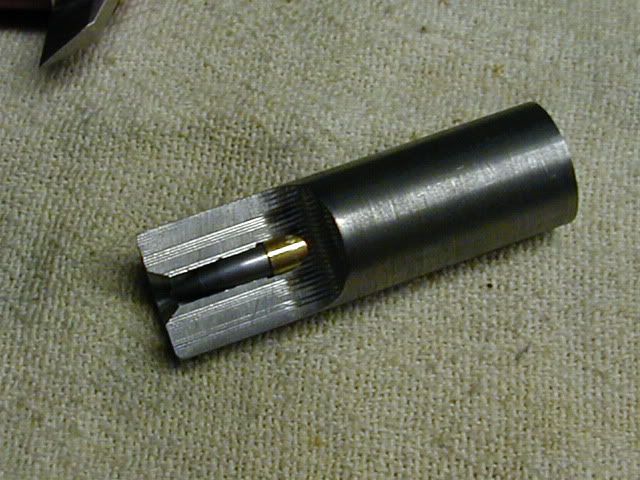Ok, had something happen in my 204 that I'm having a little trouble explaining. I got 100 new winchester cases, never fired. Out of the bag I full length sized, trimmed to specified length (1.840) according to my sierra manual, inside/outside deburred, flash hole deburred, and primer pocket reamed. I then fired 30 of the cases with H4895 and a 39 BK while working up a load (26.1 grains) and when I got home from the range I neck sized then measured my brass and found that they now vary in length from .002 to .005 shorterthan they were. So I went from 1.840 to somewhere between that and 1.835.
Correct me if I'm wrong but I don't that will be quite enough to really hurt my accuracy. Which would be disappointing cause it shoots ragged holes with that load. I'm just wondering why this happened. Brass usually grows and I've seen it shrink but not after only one firing. Usually when it shrinks its near the end of its life and has been reloaded 4 or 5 times. I haven't measured the chamber on my CZ but this hasn't happend before. Previously, my 204 cases have needed trimmed after 2 or 3 firings cause I check them with the mic every time. Anybody have an explanation? Am I missing something? Thanks...
Adam
Shrinking Brass
- Rick in Oregon
- Moderator
- Posts: 4942
- Joined: Thu Dec 01, 2005 4:20 pm
- .204 Ruger Guns: Sako 75V, Cooper MTV, Kimber 84M, Cust M700 11 Twist
- Location: High Desert of Central Oregon
- Contact:
Adam: This happens all the time with new brass on the first firing. This is the reason I never trim my new brass until it has been fireformed for my chambers in various rifles. Unless the new stuff is way over spec, no need to trim on the first go-around.
Some will claim to always trim, even brand new brass, but until it is fireformed for your chamber, it will never give gilt-edge accuracy anyway on the initial firing, so what's the point?
When I form Ackley caliber cases from new brass, it is always shorter on the first firing.
Most will trim all that once fired brass to the shortest case now, and keep an eye on the length from this point in time forward.
Some will claim to always trim, even brand new brass, but until it is fireformed for your chamber, it will never give gilt-edge accuracy anyway on the initial firing, so what's the point?
When I form Ackley caliber cases from new brass, it is always shorter on the first firing.
Most will trim all that once fired brass to the shortest case now, and keep an eye on the length from this point in time forward.
- glenn asher
- Senior Member
- Posts: 840
- Joined: Wed Feb 09, 2005 6:25 pm
- .204 Ruger Guns: Savage 12fvss, CZ 527 American
- Location: kentucky
- Contact:
Since new cases are undersized to begin with, they have to expand to fill the chambers, that brass is going OUT, not lengthening, like you've come to expect. This is especially bad since it's so undersized from the git-go.
I strongly think that the companies are making the cases too small to stretch their supplies during this crunch of materials, caused mostly by China's voracious appetite for raw materials. It's making it tough on everyone worldwide, hence the higher prices on our components. I wish they'd make their cases to spec, but I don't see it happening anytime soon.
I strongly think that the companies are making the cases too small to stretch their supplies during this crunch of materials, caused mostly by China's voracious appetite for raw materials. It's making it tough on everyone worldwide, hence the higher prices on our components. I wish they'd make their cases to spec, but I don't see it happening anytime soon.
Build a man a fire, and he's warm for a day. Set a man on fire and he's warm for the rest of his life!
Thanks for the info guys, that makes sense. I guess I shouldn't expect to see increase in length until they've been fireformed to my chamber. I just figured it would be best to start with everything uniform. In the future I'll wait to trim.
What do you guys consider way over spec for case length? I think the reason I trimmed those new cases was because they were between .005 and .010 longer than the trim to length in my manual. I know the factory chambers are generous but is there a specific amount over that should warrant trimming? Thanks again ...
Adam
What do you guys consider way over spec for case length? I think the reason I trimmed those new cases was because they were between .005 and .010 longer than the trim to length in my manual. I know the factory chambers are generous but is there a specific amount over that should warrant trimming? Thanks again ...
Adam
- Rick in Oregon
- Moderator
- Posts: 4942
- Joined: Thu Dec 01, 2005 4:20 pm
- .204 Ruger Guns: Sako 75V, Cooper MTV, Kimber 84M, Cust M700 11 Twist
- Location: High Desert of Central Oregon
- Contact:
aocasek: That's a tough one. As all chambers on factory rifles are different, without a chamber gauge that was chambered with your chambering reamer, it is difficult at best to measure.
But the rule I use, is that if the new cases are over factory max length spec by .011 - .012", I'll usually trim to the spec length, that is if I don't have a chamber gauge for that particular barrel. I've seen over length new factory cases still as much as .020" short of bottoming out at the end of the chamber.
Here's one of my chamber gauges. This particular one is for my 17 Ackley Hornet. With the cutaway, you can plainly see where the case neck would come in contact with the end of the chamber if it were too long. It is also excellent for setting seating depth of the bullet too, as you can see where the bullet engages the rifling. Under magnification, you can see a gap (if present) as small as .002" using a gunsmithing Opti-Visor of 10X; a very handy item on the reloading bench.

The bullet in the photo is a 17 ca. 20gr V-Max, coated with WS2 (Tungsten Disuplhide) Skippy really hates these babies.
But the rule I use, is that if the new cases are over factory max length spec by .011 - .012", I'll usually trim to the spec length, that is if I don't have a chamber gauge for that particular barrel. I've seen over length new factory cases still as much as .020" short of bottoming out at the end of the chamber.
Here's one of my chamber gauges. This particular one is for my 17 Ackley Hornet. With the cutaway, you can plainly see where the case neck would come in contact with the end of the chamber if it were too long. It is also excellent for setting seating depth of the bullet too, as you can see where the bullet engages the rifling. Under magnification, you can see a gap (if present) as small as .002" using a gunsmithing Opti-Visor of 10X; a very handy item on the reloading bench.

The bullet in the photo is a 17 ca. 20gr V-Max, coated with WS2 (Tungsten Disuplhide) Skippy really hates these babies.
